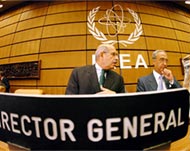IAEA ready to go back to Iraq
UN inspectors, barred from most of Iraq since the US invasion, are ready to return to investigate the disappearance of equipment that could be used in atomic weapons, the UN nuclear watchdog has said.

“We are ready, subject to security council guidance and the prevailing security situation, to resume our security council mandated verification activities in Iraq,” International Atomic Energy Agency (IAEA) spokesman Mark Gwozdecky said on Wednesday.
The IAEA, which monitored Saddam Hussein’s nuclear sites before the invasion, informed the UN Security Council that equipment and materials that could be used to make atomic weapons have been vanishing from Iraq but neither Baghdad nor Washington had noticed.
Iraq‘s Science and Technology Minister Rashad Umar said in Baghdad on Tuesday everything at the nuclear sites belonging to his ministry was accounted for and that there had been no recent disappearances.
Looting spree
 |
|
Al-Baradai says sensitive Iraqi |
“The locations that belong to the science and technology ministry are secure and under our control,” Umar said.
He said nothing had gone missing since a looting spree after the US-led invasion in March 2003, which the US and Britain said was to rid Iraq of weapons of mass destruction. Both countries now admit Iraq had no caches of banned weapons.
But a Western diplomat close to the IAEA said Umar’s comments did not appear to apply to the sites the IAEA was worried about – which may belong to Iraq‘s defence ministry.
Tuwaitha
Umar specifically referred to the Iraqi nuclear research complex at Tuwaitha near Baghdad, the one site where the IAEA has conducted limited inspections last year and this year.
|
“The locations that belong to the science and technology ministry are secure and under our control” Rashad Omar, Iraqi science and technology minister |
“The concerns raised in the [IAEA] letter centre around material and equipment in dozens of other facilities, most of which are part of the broader complex of former military-related facilities,” the diplomat said on condition of anonymity.
Satellite imagery shows entire buildings in Iraq that once housed high-precision equipment have been stripped, IAEA chief Muhammad al-Baradai said in a letter to the UN Security Council.
In 1991, the IAEA detected Saddam’s nuclear weapons programme and spent the next seven years investigating and dismantling it, before leaving the country in December 1998.
After returning in November 2002 until they were evacuated in March 2003, the IAEA was confident none of the dual-use nuclear equipment in Iraq was being used in a weapons programme.